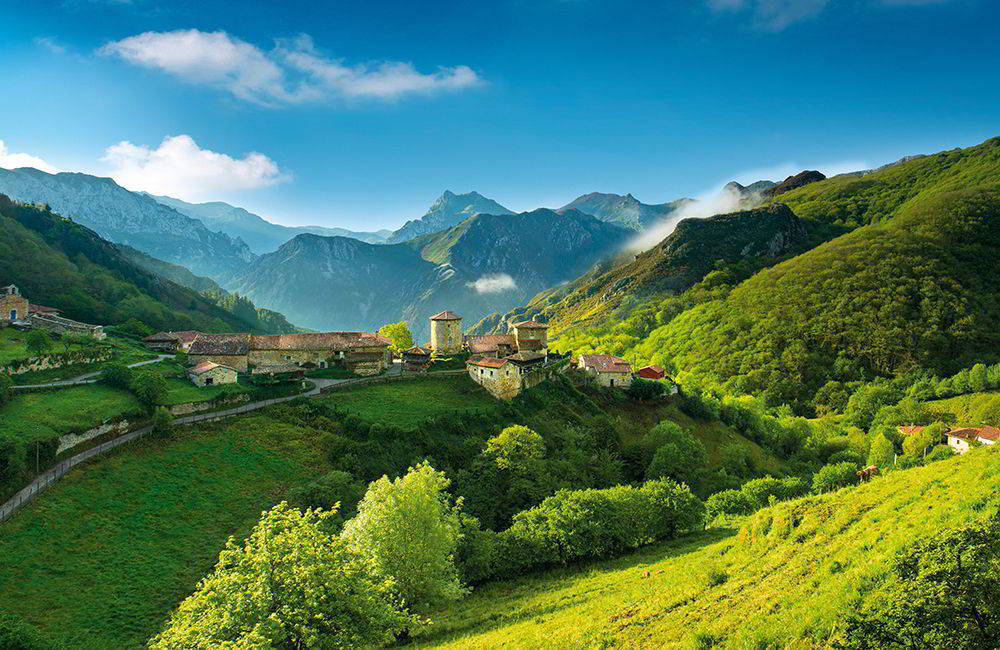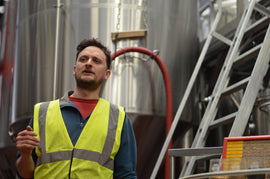If you love red wine, chances are you love Spain. And vice-versa - it’s almost impossible to imagine even the shortest visit w/out vino roja. Indeed, just add an “i” to that Spanish word for red, and you arrive at Rioja, the north central area known for the eponymous reds made mostly from Tempranillo and aged in American oak, that are probably Spain’s most famous viticultural export. (They are the best-selling.) But every one of Spain’s 17 autonomous communities makes wine, the country has more acreage under vine - around 3 million - than any other place on earth. In other words, no matter how many times you return, there is always more Spain-splaining left to do. This quarter it is España Verde’s (Green Spain) turn to talk.
Yet another example of Spain’s knack for awesome toponymy (see: Castille y Leon or Castle & Lion), España Verde is a handkerchief folded into the country’s north-western pocket square, following Atlantic coast from the Portuguese border in the south to the Iberian peninsula’s northmost promontory at the the Punta da Escata des Barres, before curving inland across the provinces of Asturias and Cantabria, and terminating at Bilbao and the beginning of Basque Country. This is, as you’d expect from the sobriquet, lush, verdant country with a temperate climate and considerable annual precipitation. (The rain in Spain falls mainly - you guessed it!) It also feels a world away from the España of yore - less bullfighters, flamenco dancing and sunkissed beaches, more Scotland south: Celtic heritage, bagpipes, rain.
So it’s no surprise the wine scene is similarly distinctive (without being like the haggis of Spain or anything.) In addition to the aforementioned Asturias and Cantabria, España Verde encompasses Galicia, which boasts the most Atlantic coastline, and is responsible for Albariño, arguably Spain’s most well-known white grape. In Galicia alone, the reds run a veritable Pamplona (actually located just east of Cantabria in Navarre) of styles and varietals from lean, vegetal reds made from grapes like Caíño and Espadeiro in Rías Baixas on the coast to more muscular and toned bottlings from Brancellao and Sousón in Ribeiro, further inland to Mencía and Merenzao in Ribeira Sacra, to even some Tempranillo (known here as Araúxa) in Monterrei. And this doesn’t even cover producers working completely outside the appellation system.
Moreover, its not just the grapes that distinguish the area from the rest of Spain: the variegated nature of the landscape means many growers work with multiple minifundios (small holdings), each with its own exposure, elevation, soil makeup, and grape varieties. The piecemeal nature of viticulture here means that wines are more likely to be shaped by terroir than by a specific house style or winemaking formula. Even within a single region, there are very different expressions. In Ribeira Sacra, wines from central, south-facing Amandi show clear differences from Atlantic, west-facing Ribeiras do Miño. In Ribeiro, grapes grown in the cooler, fresher, Avia Valley will show differently from the warmer, flatter Val do Miño. One parcel may give you ripe fruit, while another might be more floral and delicate, and another might be vegetal and crunchy.
So here are three outstanding examples of España Verde’s emerald plenty, a viticultural renaissance that is in full swing as we speak, arguably the envy of every other (less) green winemaking world right now, definitely a seed from which to expect many more sprouts in the future.
Augalevada ‘Mercenario’ Tinto 2020 |
|
|
Region / Country of Origin: Ribeiro, Spain |
About the winery: Iago Garrido may be destined to become one of Spain’s most influential winegrowers. In 2014 this former professional soccer player buried an amphora filled with Treixadura in the middle of his granite vineyard inside Ribeiro’s Avia River Valley. Initially convinced he had made a mistake with the discovery of a flor yeast veil, he later realized this errant shot actually hit a vein of gold that went on to define the direction of his wines. What makes Iago’s wines special is not only that he welcomes the influence of flor, or that he is committed to biodynamic practices in his cellar and the vineyards he owns and the ones he works directly himself, and to only using a minuscule dose of sulfur in his wines, it’s his razor-sharp attention to detail coupled with his openness to take in the ideas and opinions of others. His creative range is focused on indigenous Galician varieties with many different bottlings. About the Vineyards: Mercenario Tinto is a blend of young and old vines of Caiño Longo, Brancellao, Espadeiro and Sousón from organic and sustainably farmed vineyards in the three unofficial Ribeiro subzones Arnoia, Avia, and Miño, at 100-300m on mostly granite and gneiss bedrock with sand and clay topsoil derived from the bedrock. Winemaking: Whole cluster, 35-day natural fermentation with gentle extractions. Aged partially under flor for 10 months in 1/3 in amphora and 2/3 in 500/600l old barrels. Sulfites are added only at bottling. Unfined and unfiltered. Tasting Notes: Caiño Longo is highly aromatic, fresh and of medium structure. Its alcohol content is usually around 12%, maintaining a good acidity. Espadeiro and Sousón are sometimes referred to as “beauty and beast”. Espadeiro leads with aromas closer to the red and slightly orange fruit and dried flower side, while Sousón has big tannin, big acid, big color, and low alcohol potential. |
|
Winemaker: Iago Garrido |
|
|
Price per bottle / Price per case: $32.99/$356.30 |
|
|
Suggested Food Pairing: Grilled Meats Roasted Vegetables Aged Cheeses |
|
Pablo Soldavini ‘Lurpia’ Tinto 2022 |
|
|
Region / Country of Origin: Ribeira Sacra, Spain |
About the winery: Argentine national, Pablo Soldavini, returned to his ancestral home in Castro Caldelas inside Galicia’s Ribeira Sacra in the early 2010s. He has influenced many fellow winegrowers with his extraordinary, intuitive ability to understand the nature of any particular terroir and maximize its potential. Today, Pablo has dropped his winemaker consulting life to focus on his own projects based in Ribeira Sacra’s Ribeiras do Sil subzone with indigenous variety vineyards set at high altitudes in a largely abandoned viticultural area. Everything is done by hand with great care and a gentle approach with natural yeasts, hand harvesting and varying degrees of stem inclusion, gentle extraction (almost infusion), aging in steel or old oak and very little in the way of added sulfites. About the vineyards: Soldavini “Lurpia” is harvested from 10-year-old Brancellao grown in the Ribeira Sacra subzone “Quiroga-Bibei” with an NW exposure on a soft slope of gneiss and slate bedrock and sandy/loamy topsoil at 440m. Fun Fact: “Lurpia” is a word of Galician origin which means evil and mean-spirited woman who gets into trouble for others. It is also used as a synonym for witch. About the Winemaking: Brancellao (bron-suh-YOW) is one of the commonly found native red varieties in Galicia. It is highly resistant to Botrytis but does not have much resistance to mildew or oidium and was nearly wiped out during the powdery mildew plague of the mid-19th century. Luckily, the grape has made a comeback and is the fourth most-grown Galician red grape. It produces medium bodied wines with medium tannins and high acidity. The wine is naturally fermented with 100% whole cluster, 50% carbonic maceration, infusion extraction, at 18°C max for 7 days and aged 10 months in old 500 and 300 liters French oak barrels. Unfiltered and unfined. Tasting Notes: Subtle floral aromas as well as notes of red fruits, sweet spices, licorice and pine. Medium tannins and lots of acidity, with red fruit and herbaceous notes on the palate. Elegant and aromatic; a great summertime red. |
|
Winemaker: Pablo Soldavini |
|
|
Price per bottle / Price per case: $52.99/$572.30 |
|
|
Suggested Food Pairing: Grilled Steak Roasted Vegetables Dark Chocolate |
|
Fazenda Agricola Pradio Menica 2021 |
|
|
Region / Country of Origin: Ribeira Sacra, Spain |
About the winery: Xabi Soeanes is in love with his Galician countryside, and he’s even more taken in by its nearly forgotten past. His greatest desire, his dream, is to share this cultural treasure with the world, through the lens of his varietally blended wines—the historical winegrowing practice of this area. Fazenda Prádio (named after a local tree known as a false maple, or sycamore) is located within the Chantada subzone, one of the coldest of Ribeira Sacra, heavily influenced by the Atlantic. His 3.5ha of vines, a collection of Mencía, Caíño Longo, Merenzao, Brancellao, Godello, and other indigenous varieties, are perched on wide terraces between 180-300m that overlook the Miño River gorge and are carved out of a steep hill split with granite and schist. Xabi practiced organic and biodynamic farming for years but after a series of seasons that almost put him out of business, he keeps the door open to move freely when needed. About the vineyards: Surrounded by indigenous forests on all sides but the river side and influenced by both oceanic and continental weather, Pradio’s vines were planted in the early 2000s on south/southeast-facing terraced slope of granite and schist at 190-240m overlooking the Miño River. About the Winemaking: This 100% Mencia (men-THEE-yuh) is hand harvested, fully destemmed, and naturally fermented for 7-10 days in granite lagars (stone vats). The wine is gravity fed into older French oak barrels (mostly 500L with a few smaller sizes 300L and 225L) prior to pressing the pomace. The wines are usually racked and sulfured after malolactic and again at bottling with a total of between 30-50 ppm of sulfites Tasting Notes: Black and red fruit aromas like raspberries, blackberries, red cherries, and delicate floral notes mingle with earthy, vegetal notes and hints of black pepper. Fresh and fruity, although with some earthiness gives a good depth of flavor and complexity. A sensual and aromatic wine with a fine mouthfeel of good natural acidity and minimal tannins. |
|
Winemaker: Xabi Soeanes |
|
|
Price per bottle / Price per case: $30.99/$334.70 |
|
|
Suggested Food Pairing: White meats, legumes, spicy dishes with lamb, rice dishes |
|





